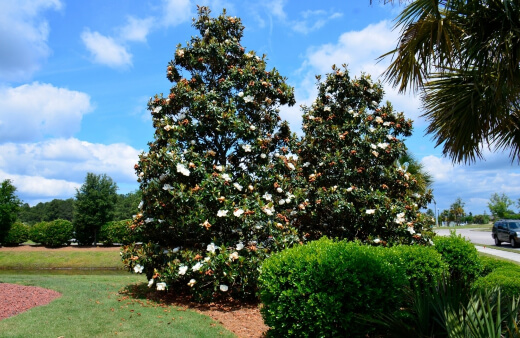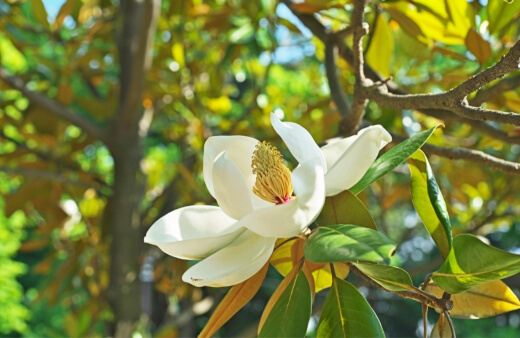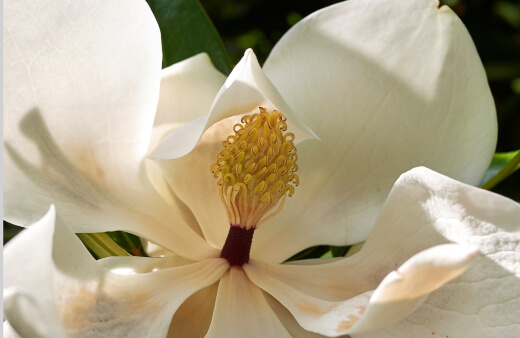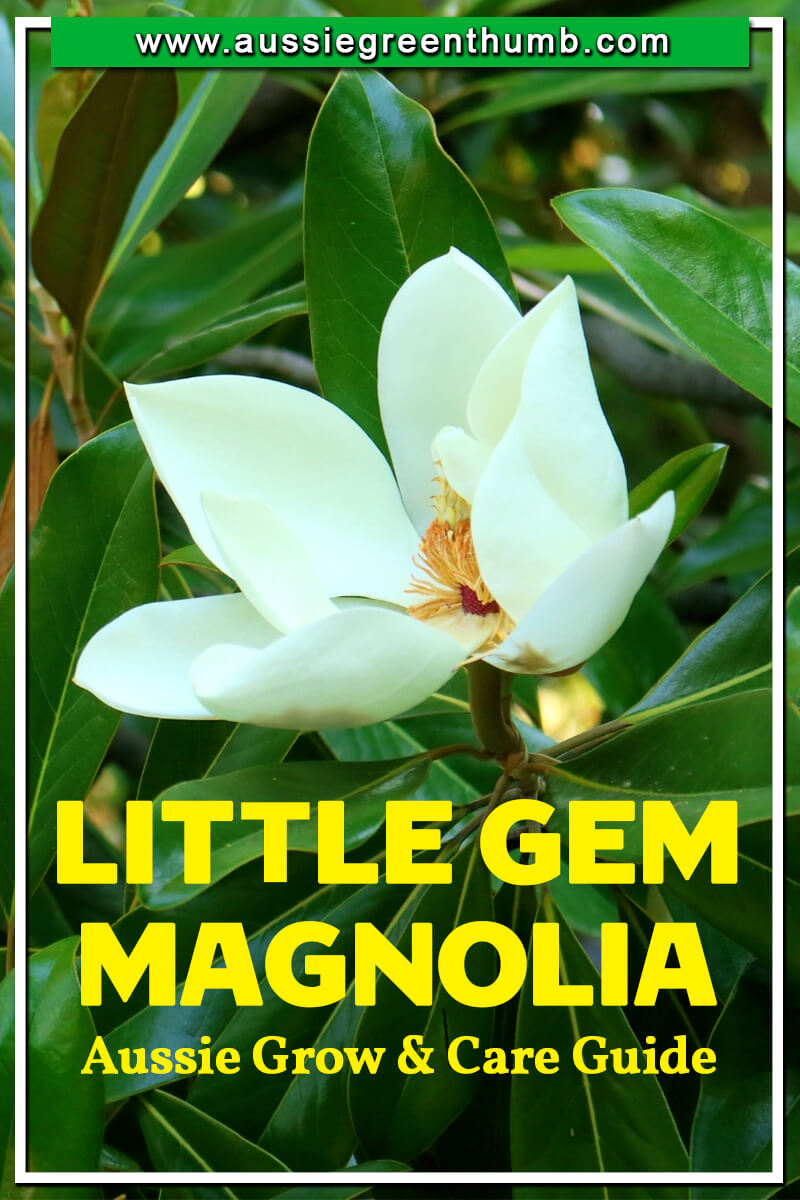Magnolia grandiflora ‘Little Gem’ is the perfect option for those who want to grow a southern magnolia tree but have limited space. This evergreen dwarf magnolia will delight your senses with fragrant white and yellow blooms, which they produce throughout the summer.
Interested in growing this stand-out landscaping specimen? Here are tips to help you plant, care for, and grow little gem magnolia.
More...
How to Grow Little Gem Magnolia

Magnolia grandiflora ‘Little Gem’, is a low-maintenance and tolerant upright grower which offers a lot of visual delight for very little space and effort.
This evergreen perennial has dense foliage, which makes it ideal as an ornamental privacy screen or hedge. The small, red-coated seeds will also attract lots of local birds to your garden.
Whether grown in the ground or in a pot, the little gem magnolia tree is easily established and won’t require too much additional care.
Being a dwarf variety, the little gem magnolia tree only grows between 7-9 metres tall. It also has a slow growth rate, which makes it ideal for growing in pots.
How Much Sun Does Magnolia ‘Little Gem’ Need?
As with most flowering plants, the little gem magnolia does require a good amount of sunlight during the day. Try to pick a spot that receives full sun or partial shade. For maximum flowering capacity, it needs at least 4 hours of direct sun per day.
What Soil is Best for Magnolia grandiflora ‘Little Gem’?
Magnolia grandiflora ‘Little Gem’ is quite tolerant and will often adapt to a range of soil conditions. However, it prefers sandy or clay soils.
If growing little gem magnolia in pots, you’ll want to choose a potting mix that is slightly acidic, loamy and moist. A general soil pH level between 5.6 and 6.5 is also recommended.
How to Propagate Little Gem

It is possible to propagate little gems either by seed or by cutting. If you have little gem growing in your neighbourhood, it is possible to find seedlings that have fallen beneath the tree.
However, many growers recommend propagation by means of cutting, as this guarantees a faster flowering tree.
Here’s what you need to do:
- Using a sterile grafting knife, remove a hardwood stem cutting from an existing, healthy tree.
- Taking cuttings in the morning is recommended as the stems will likely be most turgid.
- Using a blade, you will need to wound the base of the cutting, taking care to expose the greenish inner layer of the bark.
- Dip the wounded section into a rooting hormone.
- Plant the cutting into a sterile, fast-draining growing medium to root.
- Position your cutting in a semi-shaded area that receives lots of indirect morning light.
In cooler, coastal climates, it is recommended to keep your cuttings indoors or in a greenhouse to avoid cuttings drying out or being exposed to excessive winds.
Planting Little Gem Magnolia
When planting, be sure to give your little gem magnolia tree plenty of space to grow to its full size. It is recommended to mulch around the base of the trunk to curb the growth of any water-stealing weeds.


Get Your Free Guide:
Master Growing Australian Natives eBook
A Must Have Complete Guide for Every Australian Garden
Get Your Free Guide:
Master Growing Australian Natives eBook
A Must Have Complete Guide for Every Australian Garden
However, you should keep a little room just around the base. Planting should be done during the late autumn or early spring. If planting a Magnolia ‘Little Gem’ hedge, be sure to keep each tree at least 1.5 metres apart.
Little Gem Magnolia Care

When it comes to little magnolia tree care, there are few things you will have to worry about beyond regular watering. The little gem is not overly drought tolerant and will require a good amount of moist soil.
Especially in its first year of growth, it will require water as often as 3 to 4 times per week. Thereafter, you can cut back to once or twice a week and half of that in winter.
If you live in particularly arid parts of Australia, it’s recommended to regularly check the soil moisture level. Unlike many other plants, Magnolia grandiflora ‘Little Gem’ is able to withstand some flooding, so you won’t need to worry too much about overwatering.
During the spring, a slow-release fertiliser can be added to the soil to support growth. Especially if you are growing a Magnolia ‘Little Gem’ hedge, it is recommended to prune lightly if necessary.
As it is a slow grower, it shouldn’t be too often, and with this species, less is more. When pruning, avoid cutting off any young buds which may be growing for the next season.
Should you be looking to keep your little gem magnolia very small, it is recommended to prune regularly during the first few years of growth. This will train your little gem into a smaller shape.
Here is our review on the best pruning saws for the bigger branches and here are the best gardening secateurs for the smaller branches.
Possible Little Gem Problems
This species has been cultivated to be relatively pest and disease-free. However, there is a chance that you may have some smaller issues in unideal conditions.
The most prominent issue is Magnolia Scale. This can be easily controlled by means of horticultural oil. Other smaller issues you may incur include lead spot, blight and black mildew.
For these issues, you won’t need to look at chemical control. Simply trim off any infected leaves and branches and dispose of them.
Final Magnolia grandiflora ‘Little Gem’ Tips

- Should your little gem leaves begin to yellow, this may be due to a nutrient deficiency. Be sure to check that your soil is draining well and has enough iron.
- Due to its small size, Magnolia grandiflora ‘Little Gem’ is ideal for small balcony or patio gardens, near decks and patios or confined spaces.
- If you notice your little gem isn’t producing as many flowers as it should, it may be due to a lack of sunlight. Ensure you move it to a spot that gets enough direct sunlight throughout the day.
- If growing a Magnolia ‘Little Gem’ hedge, it is important to note that leaf, flower and seed drop can become a little messy. It is recommended to regularly clean any debris from the base of the tree to prevent the spread of any diseases.
- Magnolia roots are generally quite wide-spreading. However, they are non-invasive, so you won’t have to worry about keeping your little gems close to any other plants.
Note: Little Gem Magnolia can sometimes be mistaken as Teddy Bear Magnolia so be sure to check out complete guide on Teddy Bear Magnolia here.
Little Gem Magnolia Frequently Asked Questions
Do little gem magnolias grow fast?
These trees are considered slow growing with height increases of less than 30 centimetres per year on average.
What fertiliser is best for a little gem magnolia?
These trees prefer good amounts of nitrogen when being fed. Aim to use a fertiliser with an NPK ratio of 20-5-20 or 12-4-8. Something similar will also work fine.
What is the difference between a little gem and a teddy bear magnolia?
Little gem is a smaller tree, usually reaching only about 6 metres when fully mature. Teddy bear magnolia can grow up to 10 metres tall, perfect for those looking for a bigger magnolia tree.
What is the lifespan of a little gem magnolia?
There is limited information available on the exact lifespan of these trees, however, dwarf trees usually last a lot shorter than their larger counterparts, generally around 25 to 50 years.
How close to the house can you plant a little gem magnolia?
It is best to plant a little gem tree at least 2 metres from the house and other boundaries.
Where should you plant a little gem magnolia?
Full sun positions are best for these trees but they can also tolerate some shade thanks to their adaptable natures. They can also tolerate many soil types as long as there is good drainage.
How big is the root system of a little gem magnolia?
The root systems of these trees are wider spreading than other trees. From the trunk, the roots can cover a distance of about 4 times the canopy width.
How long does it take for a little gem magnolia to mature?
These compact trees can take 2 to 3 years to reach full maturity in good conditions.
Can a Magnolia ‘Little Gem’ grow in pots?
This variety is a great choice for pots and in-ground containers where it will grow to around 2 to 3 metres in height. Growth can be better contained when planted in pots to help retain a shapely and ornamental appearance.
Do little gem magnolias lose their leaves?
Even though this tree is evergreen, it will still drop an abundance of leaves from spring to early summer.
Check out our main Magnolia post to discover more varieties to grow in your backyard.

Start Growing Little Gem Magnolia Today!
Now is the perfect time to start growing your little gem magnolia. When planting, just be sure to pick the right spot with plenty of sunlight and support your little gem magnolia tree with lots of water for the first few months.
For more plants to grow in your garden, be sure to check our Dahlia and Ranunculus growing guides.
While it may take a year or two before your little gem magnolia begins to flower, it will definitely be worth the wait!
Published on January 3, 2023 by Gary Clarke
Last Updated on September 20, 2024





Hello!
We live in Lindfield NSW. an open and sunny location. 12 years ago we planted 8 magnolias, "Little Gem"just inside our low front fence, 7 of them in the soil, one in a 600mm pot. The latter was a gift from our lanscape gardener upon completing his work in a new garden.
The seven trees were then less than a meter tall, the one in the pot about 1.5 metres. Now seven are about 2 metes tall and doing well, they have overtaken the one in a pot in height.
Also, they have lots of leaves, the one in a pot has far fewer and looks a bit "starved", although it still flowers QUESTION: Why is the one tree in a pot not keeping up with the others? Its pot is about 600mm wide and 500mm tall. It is watered and feritlised regularly (with Camellia/Azalea fertiliser).
Does it need a bigger pot? More water? More fertliser? We would really value your advice. We could send photos comparing the one tree in a pot with the other seven, but I don't think this message system allows attachments..
Many thanks,
Nick Berg
Hi Nick,
Thanks for all the information.
In my opinion, it is very likely that your potted little gem has simply outgrown the 600mm x 500mm pot after all these years.
This has probably led to the roots becoming overcrowded and suffocated in the container, ultimately leading to your tree looking starved with a stunted growth habit.
Based on your explanation, I’m confident in assuming your care routine is great, especially considering your other seven magnolias are flourishing.
Generally, it is advised to repot magnolia trees every 3 to 5 years into larger containers to maintain healthy root systems and overall plant vigour.
I would suggest repotting your little gem into a larger container now before temperatures begin dropping too low as we head into autumn. You can also wait until spring if you prefer.
When repotting, use fresh soil and some compost then give your tree a good watering and feed with your usual fertiliser mix. This should reinvigorate its growth and stimulate more development in the roots which will lead to it growing larger and healthier over time.
Wishing you continued success with your magnolias!
Gary Clarke
hi Gary,
thank you for your helpful article on Little Gems. I planted 5 of them three years ago and they are a little closer than recommended zigzagged at 1m to create a small hedge in my front yard. They are all doing well but I have decided to put in a pedestrian gate where the middle one is. I am concerned about transplanting but also about upsetting the root structure of the others closest to it. Do you have experience with shifting them once they've been established for that long? I just want to know if I can hope for all to survive or if it's more likely I'll lose them.